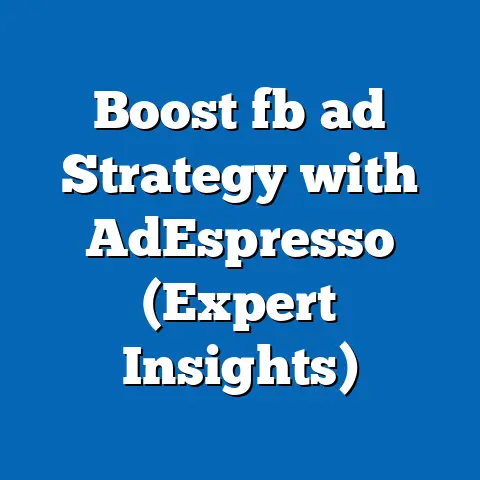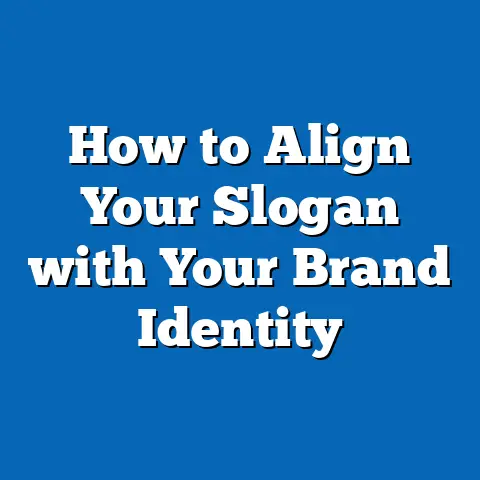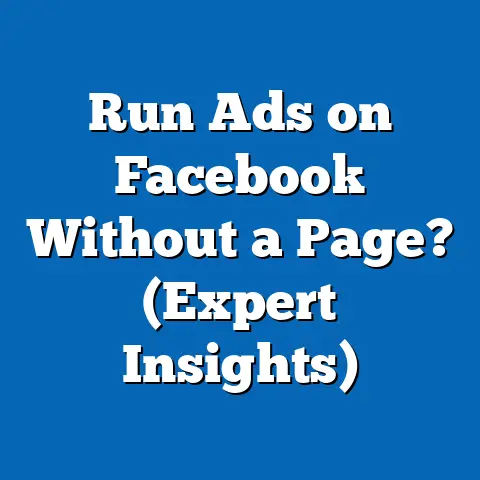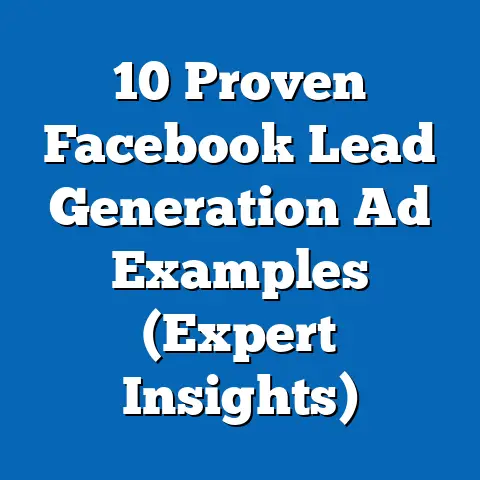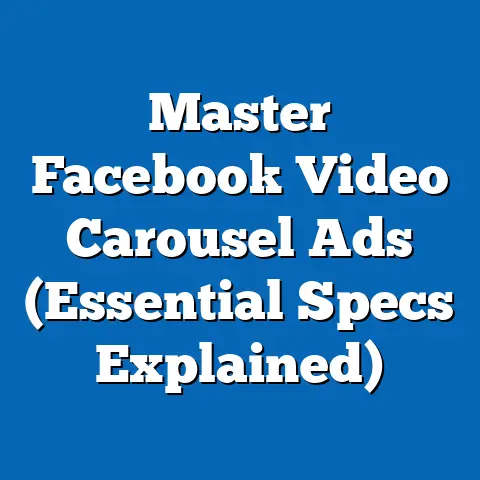Drive Results with Facebook App Ads (Ultimate Guide)
In the fast-evolving landscape of digital marketing, where trends shift with the swipe of a finger, the power of nostalgia remains a timeless tool for connecting with audiences. Nostalgia, a sentimental longing for the past, resonates deeply across generations, tapping into shared cultural memories and personal experiences. For marketers aiming to drive results with Facebook App Ads, leveraging nostalgia offers a unique opportunity to engage users by invoking emotional connections to specific eras, events, or trends that shaped their identities.
Section 1: The Power of Nostalgia in Marketing
Nostalgia is more than just a fleeting emotion; it is a psychological trigger that can influence consumer behavior in profound ways. Research from the Journal of Consumer Research (2014) suggests that nostalgia fosters a sense of social connectedness, making individuals more likely to engage with brands that evoke memories of shared cultural moments. For Facebook App Ads, which thrive on emotional resonance and immediate engagement, nostalgia can be a powerful hook to draw users into downloading or interacting with an app.
Across generations, nostalgia manifests differently, shaped by the unique historical and cultural contexts in which individuals came of age. For instance, Baby Boomers might respond to references of post-World War II optimism or the cultural revolution of the 1960s, while Millennials may connect with early 2000s pop culture or the rise of social media. Understanding these nuances is critical for tailoring ad content that feels authentic rather than forced or exploitative.
Moreover, nostalgia in marketing is not just about looking backward; it’s about creating a bridge between past experiences and present desires. A 2020 study by the American Marketing Association found that nostalgic campaigns often lead to higher brand trust and purchase intent, as consumers associate familiar memories with reliability. For app marketers, this means nostalgia can drive not only clicks and installs but also long-term user retention.
Section 2: Generational Characteristics and Historical Context
To effectively leverage nostalgia in Facebook App Ads, marketers must first understand the generational cohorts they are targeting. Each generation is shaped by distinct historical events, technological advancements, and cultural shifts, which influence their values, behaviors, and media consumption habits. Below, we explore key generations commonly targeted in digital advertising, focusing on their defining characteristics and the contexts that shaped them.
2.1 Baby Boomers (Born 1946–1964)
Baby Boomers grew up in an era of post-war prosperity and significant social change. Key events like the Civil Rights Movement, the Vietnam War, and the moon landing shaped their worldview, fostering a mix of optimism and activism. Boomers were the first generation to grow up with television, making them responsive to traditional media references and iconic imagery from the 1950s and 1960s.
In terms of nostalgia, Boomers often connect with themes of family values, classic rock music, and vintage Americana. For app ads, marketers can tap into these sentiments by using retro visuals or music from their formative years, though it’s important to avoid caricatures and focus on authentic storytelling.
2.2 Generation X (Born 1965–1980)
Often called the “latchkey generation,” Gen X grew up during a period of economic uncertainty, with rising divorce rates and the advent of dual-income households. They witnessed the end of the Cold War, the rise of MTV, and the early days of personal computing. As a result, Gen X values independence, skepticism toward institutions, and adaptability.
Nostalgia for Gen X often centers on 1980s and early 1990s pop culture—think arcade games, blockbuster movies like “The Breakfast Club,” and the grunge music era. Facebook App Ads targeting this group can incorporate pixelated graphics or references to early internet culture to evoke a sense of familiarity and playfulness.
2.3 Millennials (Born 1981–1996)
Millennials, also known as Gen Y, came of age during the dot-com boom, the aftermath of 9/11, and the 2008 financial crisis. They are often characterized as tech-savvy, socially conscious, and value-driven, shaped by the rapid rise of the internet and mobile technology. This generation saw the birth of social media platforms like MySpace and early Facebook, making them particularly attuned to digital trends.
Nostalgia for Millennials often revolves around early 2000s culture—think flip phones, boy bands, and the dawn of reality TV. For app ads, incorporating memes, Y2K aesthetics, or references to iconic early internet moments (like dial-up sounds) can resonate strongly with this cohort.
2.4 Generation Z (Born 1997–2012)
Gen Z is the first fully digital-native generation, growing up with smartphones, social media, and instant access to information. They’ve been shaped by events like the Great Recession, climate change activism, and the COVID-19 pandemic, fostering a pragmatic, socially aware, and entrepreneurial mindset. Unlike Millennials, Gen Z values authenticity over polished content and often engages with platforms like TikTok over traditional social media.
Nostalgia for Gen Z is unique, as many are drawn to “retro” trends from the 1990s and early 2000s that they didn’t experience firsthand. Facebook App Ads targeting Gen Z can experiment with vintage filters, throwback slang, or collaborations with influencers who embody these aesthetics, ensuring content feels genuine and trend-driven.
Section 3: Societal Implications of Generational Nostalgia in Advertising
The use of nostalgia in marketing, particularly through platforms like Facebook, carries broader societal implications. On one hand, nostalgic content can foster a sense of unity by bridging generational divides, as shared cultural touchpoints create common ground. For instance, a Facebook App Ad referencing a universally recognized moment—like the release of a groundbreaking video game—can appeal to both Gen X parents and their Gen Z children, albeit for different reasons.
However, there are risks to consider. Over-reliance on nostalgia can alienate audiences if it feels inauthentic or pandering, particularly for younger generations like Gen Z, who prioritize transparency and originality. Additionally, nostalgia can reinforce cultural stereotypes or exclude marginalized groups whose experiences may not align with mainstream historical narratives.
Marketers must also navigate the ethical dimension of evoking emotional responses for commercial gain. While nostalgia can build brand affinity, it can also be perceived as manipulative if not executed with care. A 2019 study by the University of Southern California found that 62% of consumers are wary of brands that overuse sentimental tactics, emphasizing the need for balance and relevance in nostalgic campaigns.
Section 4: Understanding Facebook App Ads – Mechanics and Opportunities
Before diving into how nostalgia can be integrated into campaigns, it’s essential to understand the fundamentals of Facebook App Ads. These ads are specifically designed to drive app installs, re-engagement, or in-app actions, leveraging Facebook’s vast user base and sophisticated targeting tools. With over 2.9 billion monthly active users as of 2023 (Statista), Facebook offers unparalleled reach across generational demographics.
4.1 Key Features of Facebook App Ads
Facebook App Ads allow marketers to create visually engaging content with clear calls-to-action (CTAs) like “Install Now” or “Play Today.” They support multiple formats, including image, video, carousel, and playable ads, which are particularly effective for gaming apps. Additionally, Facebook’s algorithm optimizes ad delivery based on user behavior, ensuring ads reach individuals most likely to convert.
Targeting options are a cornerstone of success with Facebook App Ads. Marketers can segment audiences by age, location, interests, and even life events, making it easier to tailor nostalgic content to specific generational cohorts. For example, a fitness app targeting Baby Boomers might use imagery of 1960s workout trends, while a music streaming app for Millennials could reference early iPod ads.
4.2 Why Nostalgia Works on Facebook
Facebook’s platform is inherently social, with users often engaging with content that sparks personal or collective memories. Features like Groups and Pages dedicated to retro content or past decades amplify the reach of nostalgic themes. Moreover, the platform’s older user base—particularly Boomers and Gen X—makes it a fertile ground for campaigns rooted in historical references, while younger users still engage with ironic or curated throwback content.
Section 5: Crafting Nostalgic Facebook App Ads – Strategies by Generation
Integrating nostalgia into Facebook App Ads requires a nuanced approach that respects generational differences while aligning with campaign goals. Below are tailored strategies for each cohort, grounded in their historical and cultural contexts.
5.1 Baby Boomers: Emphasize Tradition and Stability
For Baby Boomers, nostalgia should evoke a sense of simpler times or iconic cultural moments. Ads for productivity or health apps could use black-and-white imagery, classic jingles, or references to mid-20th-century family life. The tone should be warm and reassuring, focusing on trust and reliability.
Example: A financial planning app ad featuring a 1950s-style family gathering with a modern twist, paired with a CTA like “Plan for Your Future, Today.”
5.2 Generation X: Highlight Independence and Pop Culture
Gen X responds well to nostalgia that celebrates their formative years of self-reliance and counterculture. Ads can incorporate 80s and 90s aesthetics—neon colors, VHS effects, or quotes from cult classic films. Humor and irony work well with this group, as they often appreciate a less polished, more authentic vibe.
Example: A gaming app ad with pixelated graphics reminiscent of early Nintendo games, with a tagline like “Game Like It’s 1995.”
5.3 Millennials: Tap Into Digital Nostalgia and Social Trends
Millennials are drawn to nostalgia tied to the early internet era and pop culture phenomena. Ads should use Y2K-inspired designs, references to iconic TV shows like “Friends,” or early social media memes. Interactive elements like polls or quizzes about past trends can boost engagement.
Example: A social networking app ad featuring a throwback to MySpace with customizable profiles, encouraging users to “Relive the Top 8.”
5.4 Generation Z: Curate Retro Trends with Modern Relevance
For Gen Z, nostalgia is often a curated experience rather than a lived one. Ads should blend retro elements with contemporary trends, such as 90s fashion paired with TikTok-style editing. Collaborations with influencers who embody “vintage cool” can enhance authenticity.
Example: A photo editing app ad using a 90s polaroid filter effect, promoted by a Gen Z influencer with a caption like “Make It Retro, Keep It Real.”
Section 6: Best Practices for Nostalgic Facebook App Ads
While nostalgia is a powerful tool, its effectiveness depends on strategic execution. Below are best practices to ensure campaigns resonate with target audiences and drive results.
6.1 Authenticity Over Exploitation
Avoid overusing nostalgic tropes to the point of cliché. Research the specific cultural references that matter to your audience, and ensure they align with your app’s value proposition. For instance, a meditation app referencing 1960s counterculture should focus on themes of peace and mindfulness, not just generic hippie imagery.
6.2 Visual and Auditory Cues
Leverage design elements and music that evoke specific eras. A 2021 Nielsen study found that 78% of consumers are more likely to remember ads with familiar songs or sounds. For example, using a chiptune soundtrack for a Gen X-targeted gaming app ad can instantly transport users back to the 80s.
6.3 Test and Optimize
Use Facebook’s A/B testing tools to experiment with different nostalgic themes and measure their impact on click-through rates (CTR) and install rates. Monitor audience feedback through comments and engagement metrics to refine content. Data from Facebook Ads Manager shows that campaigns with iterative testing see up to a 30% improvement in performance.
6.4 Balance Nostalgia with Modernity
While nostalgia draws users in, the ultimate goal is to promote a modern app. Highlight how your app improves upon past experiences or solves current pain points. For example, a music app ad could contrast vinyl records with seamless streaming, blending old and new.
Section 7: Measuring Success and Analyzing Impact
Driving results with Facebook App Ads requires a clear framework for measuring success. Key performance indicators (KPIs) include app install rates, cost per install (CPI), user retention, and in-app purchases. Nostalgic campaigns should also track engagement metrics like shares, comments, and video view completion rates, as these indicate emotional resonance.
Beyond quantitative metrics, qualitative feedback is invaluable. Monitor user reviews and social media conversations to gauge whether nostalgic elements are perceived as genuine or gimmicky. A 2022 report by Hootsuite revealed that 54% of users share ads they find emotionally impactful, underscoring the viral potential of well-executed nostalgic content.
From a societal perspective, nostalgic ads can influence cultural narratives by reviving interest in past trends or sparking intergenerational dialogue. However, marketers must remain mindful of perpetuating outdated stereotypes or alienating segments of their audience through overly narrow historical references.
Section 8: Case Studies – Nostalgia in Action
8.1 Spotify’s “Wrapped” Campaign
Spotify’s annual “Wrapped” feature, often promoted through Facebook Ads, taps into personal nostalgia by summarizing users’ listening habits with a retro-themed design. By referencing past decades’ music trends and pairing them with modern data visualization, Spotify appeals to a wide range of generations. In 2022, Wrapped ads achieved a 25% higher engagement rate compared to standard campaigns (AdWeek).
8.2 Nintendo Switch Retro Ads
Nintendo has successfully used nostalgia in Facebook App Ads for Switch games by recreating classic 80s and 90s gaming ads. Targeting Gen X and Millennials, these ads feature vintage console imagery alongside modern gameplay, driving significant app installs for retro-inspired titles. Their campaigns saw a 40% increase in CTR during nostalgic holiday promotions (Marketing Dive, 2021).
Section 9: Challenges and Ethical Considerations
While nostalgia is a potent marketing tool, it comes with challenges. One major hurdle is ensuring cultural sensitivity, as historical references can inadvertently exclude or offend certain groups. For instance, focusing solely on mainstream Western nostalgia may alienate users from diverse backgrounds whose cultural touchpoints differ.
Additionally, there’s the risk of “nostalgia fatigue,” where overexposure to retro themes dilutes their impact. Marketers must innovate continuously, blending nostalgia with forward-thinking content to maintain relevance. Ethical concerns also arise around exploiting emotional vulnerabilities, particularly for older generations who may feel disconnected from modern technology.
Section 10: Future Outlook – Nostalgia in a Digital Age
Looking ahead, the role of nostalgia in Facebook App Ads will likely evolve with emerging technologies like augmented reality (AR) and artificial intelligence (AI). AR ads could recreate past environments for users to interact with, while AI can personalize nostalgic content based on individual user data. However, as privacy regulations tighten, marketers must balance personalization with transparency to maintain trust.
Generational shifts will also shape future strategies. As Gen Z matures and Alpha Generation (born 2013 onwards) enters the digital space, nostalgia may take on new forms, potentially focusing on early 2010s internet culture or even real-time “micro-nostalgia” for recent trends. The challenge will be adapting to these fluid definitions while retaining the emotional core of nostalgic marketing.
Conclusion
Leveraging nostalgia in Facebook App Ads offers a compelling way to drive results by connecting with users on an emotional level. By understanding the defining characteristics and historical contexts of different generations—from Baby Boomers to Gen Z—marketers can craft campaigns that resonate deeply while avoiding the pitfalls of inauthenticity or exclusion. The societal implications of nostalgic advertising are vast, influencing cultural narratives and intergenerational bonds, but they require careful ethical consideration.
As technology advances and generational dynamics shift, the interplay between past and present will remain a fertile ground for innovation in digital marketing. While the future of nostalgia-driven ads is uncertain, one thing is clear: when executed with authenticity and strategic insight, nostalgia can transform a simple app install into a meaningful connection. Marketers who master this balance will not only drive immediate results but also build lasting brand loyalty in an increasingly competitive digital landscape.

